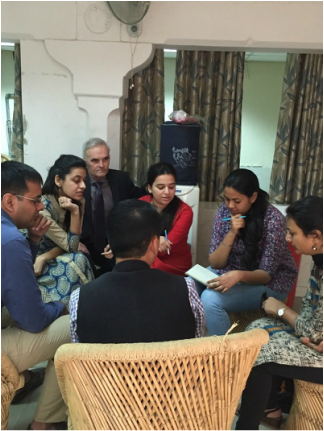|
*Photo by Kimi Tuke Daily, I walk the streets of Varanasi, India passed Brahma bulls, goats, and water buffalo mixing it up with bicycle driven rickshaws, motorized rickshaws, and buffed out taxis on my way to our apartment here in Varanasi, India. I am stunned at how in just 85 days, it all feels so normal. While walking the backroads in Pushkar, India yesterday, I was surrounded on all sides by a troop of monkeys, some not more than an arm’s length away. We can’t really replicate these experiences virtually. The toxic taste of fear mixed with excitement I swallow while walking through a troop of hungry langur monkeys is not experienced in the same way by watching it on a live webcam or recorded video.  Ambedkar U. faculty engaged in Project-based learning exercise. Ambedkar U. faculty engaged in Project-based learning exercise. While leading a workshop for university faculty on global collaborative learning in Delhi this week, one participant said, “This stuff sounds good, but do students really learn better and more deeply than how we do it now, lecturing, or is this just the latest new thing?” It’s a critical question to ask. There is strong, empirical evidence that clearly shows we learn better by listening AND doing, not just listening. And the evidence is really clear that some things demand that we practice them to learn them. It is the rare person that learns a musical instrument by reading about it, watching, and then being able to play. I found this out early in my adult career when I picked up the banjo. My family had to suffer through me practicing, of course, but they knew I would never get better unless I did. Learning to communicate across cultures so we better understand each other and can work together in global teams to solve real-world problems is like that. There is a good deal of enthusiasm here in India for these global, virtual, project-based learning strategies. I spoke at two Indian universities last week on these topics and head out next week to present at a conference of 300 faculty in Chennai, India. Yet, despite the enthusiasm, they face real obstacles here….perceived student resistance to changing up teaching practices, examination pressures of teaching to the test, tradition, and a lack of confidence in the technology. One faculty member said it puts the teacher in the position of not knowing something and looking bad. Despite all this, after each workshop, there are several faculty in every group who come forward and want to take the next concrete steps forward to pilot something. We will never, in my lifetime, get the majority of university students in countries across the world to go live and learn with each other in a foreign land, and experience being surrounded by a troop of hungry monkeys (or people quite unlike oneself). But we might get most of us living and learning with each other, side by side using virtual means.
7 Comments
|
AuthorGreg Tuke teaches and travels internationally, working with university faculty in India, Indonesia and the MIddle East, sharing strategies for implementing international collaborations within course work. This blog chronicles key experiences and insights about those experiences. All opinions expressed are mine, and represent no other institutional affiliation. Archives
March 2020
Categories |


 RSS Feed
RSS Feed